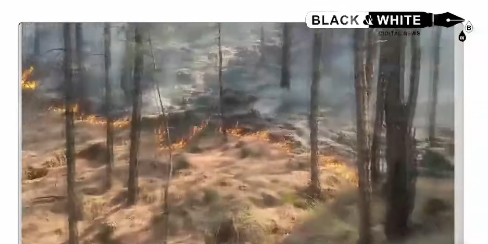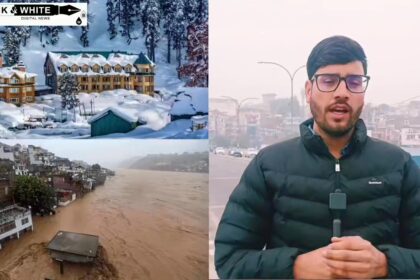Jammu & Kashmir – A Region Under Siege by Unrelenting Flames
||Black and White Digital News||
||Tejveer Singh May 31, 2024||
As the mercury continues to rise across Jammu and Kashmir, a series of devastating forest fires have wreaked havoc, engulfing vast forest areas and causing immense damage to both natural resources and wildlife. The ongoing heatwave has been the catalyst for this relentless destruction, with new fires reported daily for the past fortnight, alarming residents and authorities alike.
The Scale of Devastation: Uncontrolled Blazes Sweep Through Udhampur.
One of the hardest-hit areas is Udhampur district, where a massive uncontrolled forest fire has swept through large swathes of land, causing extensive damage. The fire, which began in the Darsoo forest area between Udhampur and Jammu districts, has spread across five to six square kilometers. Efforts by the Forest Department and local residents to control the blaze have been largely unsuccessful, prompting residents to demand the deployment of Indian Air Force helicopters for aerial firefighting support.
“We urge the administration to deploy helicopters from the IAF to douse the fire. The current efforts by the Forest Department and locals have been insufficient, and the fire is spreading to new areas rapidly,” local resident Javed Iqbal implored. “It has caused enormous losses, and immediate aerial support is crucial.”
Kathua and Rajouri: A Grim Situation.
The situation is equally grim in the Kathua and Rajouri districts, where fires have caused significant damage to forest wealth. On Tuesday, a fire broke out in the Sawni Sassalkote forest area in Rajouri, rapidly spreading due to strong winds. The combined efforts of the Forest Department, Forest Protection Force, and local residents have been ongoing, but the blaze remains a serious threat.
According to the Fire Service Department, there are currently 10 to 13 fire incidents occurring daily in the region, a direct consequence of the rising temperatures. In the Darsoo area of Udhampur, near about two and a half to three kilometers of forest land has been engulfed by the fire, with locals reporting that it is spreading further. Similarly, Gangra hills in the Panchari area of the district were recently devastated by another fire, causing extensive damage to forest resources.
Bani and Kandi Belt: Community Efforts to Contain the Blaze.
In the Bani-Kandi belt of Kathua district, locals have managed to bring fires under control after intense efforts. However, the frequency and intensity of these fires have been increasing, with eight incidents reported in the Rajouri Forest division alone. The Forest Department officials admitted that this summer has seen a notable increase in forest fires compared to the previous year, attributing this surge to the peak summer season and the accumulation of flammable pine needles in the jungle.
South Kashmir: The Forest Fires Spread to Anantnag.
The fires have not spared South Kashmir either. A massive forest fire broke out in the Nagras area of Qazigund in Anantnag district, causing significant losses. Similarly, in the Butni area of Rajouri, fires have engulfed seven to eight acres, severely damaging trees and wildlife. The Forest Protection Force has been conducting extensive firefighting operations to control these blazes, often working through the night.
Samba and Reasi: Battling the Flames on Multiple Fronts.
In Samba district, bordering Udhampur, fires have caused substantial damage in the Hardoniyan, Bagan, and Rayor Jatal areas. Reasi district has also been battling multiple forest fires, including those near the Trikuta Parvat mountains and in the Batora Chakli forest area. The administration has deployed concerned teams, including forest staff and shrine board staff, to tackle these fires. Drones have been put into service to control fires in inaccessible areas.
Expert Opinions and Community Calls for Action.
Principal Chief Conservator of Forests, K Ramesh Kumar, attributed the increasing forest fires to unprecedented soaring temperatures and the practice of burning agricultural waste near forest areas. He also noted that in some cases, miscreants might have deliberately set fires to defame the Forest staff. Kumar emphasized the need for police action in such cases.
Sarvesh Langer, Assistant Director of Fire and Emergency Services in Udhampur, highlighted the department’s preparedness. “Fire stations are well equipped with fire tenders, and we launch firefighting operations on a war footing whenever we receive reports of forest fires. In areas inaccessible to fire tenders, officials from both the Forest Department and Fire Services manually work to extinguish the fires,” he said.
Fixing Accountability in the Wake of Forest Fires: Who’s Responsible?
In the aftermath of the devastating forest fires in Jammu and Kashmir, accountability has become a pressing issue. Principal Chief Conservator of Forests, K Ramesh Kumar, suggested that some fires might have been deliberately set by miscreants aiming to defame forest officials. This raises critical questions about responsibility and the need for stringent measures to identify and prosecute those responsible.
The loss of greenery and plants has been catastrophic, stripping the region of its verdant landscape and leading to severe environmental degradation. Already, residents are suffocating from the thick smoke, and the destruction of this “green gold” signifies a monumental ecological loss.
The fires have also taken a toll on endangered species, threatening the biodiversity that thrives in these forests. Despite the urgency, the response has been hampered by a lack of adequate firefighting equipment and staff. The absence of new technology and modern methods to control forest fires has further exacerbated the situation.
This crisis prompts a significant question: why has there been a failure to invest in and deploy advanced firefighting technologies to protect these vital forest areas? Addressing these shortcomings is crucial for preventing future disasters and ensuring the sustainability of Jammu and Kashmir’s forest ecosystems.
The escalating frequency of these fires and their devastating impact have created panic among residents, especially those living near forest areas. The community’s calls for immediate and robust intervention underscore the urgent need for comprehensive strategies to combat this environmental crisis.
As Jammu and Kashmir continues to battle these relentless fires, the collective efforts of authorities, local residents, and specialized forces will be crucial in mitigating further damage and protecting the region’s invaluable natural heritage.
Leave a comment
You Might Also Like
The RSS Whose Ideology BJP Follows Did Not Hoist the Indian Flag at Its Office for 50 Years: T.S. Tony
The RSS Whose Ideology BJP Follows Did Not Hoist the Indian Flag at Its Office for 50 Years: T.S. Tony…
0 Min Read
CM Omar Abdullah Flags LG Manoj Sinha Interference in J&K Governance, Says Centre Supportive Except On Statehood
CM Omar Abdullah Flags LG Manoj Sinha Interference in J&K Governance, Says Centre Supportive Except On Statehood #OmarAbdullah #JammuAndKashmir #JKPolitics…
0 Min Read
Nashe Se Dour Rahe Sports Me Hisa Le Cabinet Minister Satish Sharma
Nashe Se Dour Rahe Sports Me Hisa Le Cabinet Minister Satish Sharma #SayNoToDrugs #DrugFreeYouth #StayAwayFromDrugs #ChooseSports #SportsForLife #HealthyYouth #FitIndia #YouthEmpowerment…
0 Min Read
Snowfall Likely in Higher Reaches of Kashmir; Rain Expected in Plains of J&K Till December 22: Meteorological Department Yeh Facebook ke liye SEO-friendly hashtags hain:
Snowfall Likely in Higher Reaches of Kashmir; Rain Expected in Plains of J&K Till December 22: Meteorological Department Yeh Facebook…
0 Min Read








